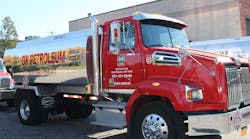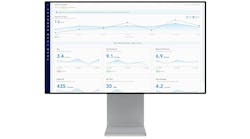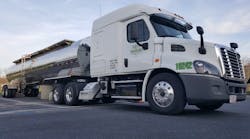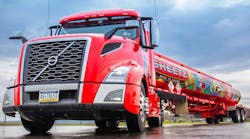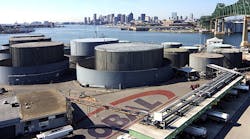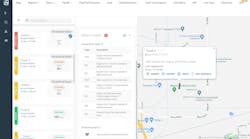PORTS, transportation and logistics will change more in the 10-year period between 2015 and 2025 than they have in the 50 years since the first container ship sailed from New Jersey to the Port of Houston with 40 containers on it in 1956, according to KC Conway, chief economist of Colliers International.
In “All Aboard: Port and Infrastructure Preparation for the First Post-Panamax Decade (2015-2025),” Conway said the Panama Canal Expansion appears to be not just a big deal, but a big financial deal. Conway made his presentation during the 2013 Intermodal Bulk Liquid Symposium held October 17 in Kemah, Texas.
In September 2007, work began on a $5.2 billion project to expand the Panama Canal. When it is completed by the middle of 2015, it will allow ships two-and-a-half times the size of current Panamax vessels to pass through the canal.
The Ports of Los Angeles and Long Beach are spending $1 billion this year and will spend over $5 billion in CapEx in the next five years to upgrade for Post-Panamax.
“That’s the equivalent of the Panama Canal,” Conway said, “and they are not doing that with federal funding. They’re doing that mostly with state funding.
“Los Angeles, Long Beach, New York, Houston, Charleston, and Georgia Ports-Savannah are the top five in North America in CapEx spending at $1.9 billion this year. These are places that are investing in roads, rail, bridges, efficiencies, and automation to make all the pieces work, because every piece of cargo starts and ends with a truck movement. If it’s a raw material or whatever, the first thing that moves it is a truck and the last thing that delivers the finished product from Amazon is a truck. Los Angeles and Long Beach in the next five years will spend the equivalent of the Panama Canal. That is mind-boggling.”
Conway said the ports’ CapEx plans are so high because Congress has raided the harbor maintenance tax and failed to fund growing needs for infrastructure maintenance, improvement, and growth.
America’s infrastructure needs a $3.6 trillion investment by 2020 just to get a “B” grade, he said.
“What is the United States’ annual spending budget? $3.8 trillion,” he said. “Our infrastructure deficiencies are because of what hasn’t been kept up with, and the raiding of the harbor maintenance tax is almost the equivalent of what we spend as a government on an annual basis. And $780 billion of that $3.8 trillion is borrowed money. Here’s what is more atrocious: You guys have already paid into this.
“What has been paid has been pirated away. You paid harbor maintenance taxes and this government has skimmed away the money, which means little is going to the infrastructure. There has been debate in Congress on what to do with the harbor maintenance tax. This is something that pays for all of our dredging, our inland waterways, the barge traffic. And the government steals it away and you don’t get what you need. If we don’t fix the problem, we’re looking at $3.6 trillion in infrastructure deficiencies. We could build a lot of Panama Canals right here in Texas. We could dredge all the way to Amarillo and we wouldn’t hit the trillion-dollar range.”
He said most people erroneously think that a 50-foot dredged channel is necessary.
“Savannah is the shallowest port in America and the third-busiest container port, and it will probably surpass New York in two years,” he said. “In Florida, there are a number of ports that figured this out. There will be only one dredged 50-foot Panama port in all of Florida: Miami.
“We’re going to end up with a total of 11 ports in North America that will be Panama-ready. There was only one on the entire East Coast until January this year: Norfolk, Virginia. When people say it can’t get done, try dredging the Chesapeake Bay and then having to squeeze Panamax cranes under the bridge. They did all of that under budget.
“Baltimore will be one of the sleeper stories that will kick the tail out of New Jersey and New York. They’re already in the process of stealing all of the auto trade business out of New Jersey and New York. Mazda just announced they will exclusively use Baltimore. BMW and Mercedes will all go out of Baltimore.”
He said it’s important to focus on post-Panamax, ports, and supply chains right now because the global supply chain is being remade.
“The route from Hong Kong into Southern California is the longest route—going into Port Rupert, Canada, is actually shorter,” he said. “Ships can sail in there and they don’t have to pay a harbor maintenance tax, which is about $1,000 per container. And it’s $350 to $400 to put it on rail and drop it into Chicago, Indianapolis, or all the way into the Gulf. The Canadian National rail line is the only one that can export from Rupert to the Gulf Coast in Mobile, Alabama, and no one’s paying any attention to it. Kansas City Southern is the only railroad that connects all the way to Mexico through Dallas, Texas.
“Major clients are making huge decisions on distribution centers and logistics in Dallas because Kansas City Southern runs through it and connects all the way down to Port Manzanillo in Mexico. Mexico’s already figuring it out. They will have two post-Panamax ports within five years. And they will do whatever they need on the ground in the infrastructure, and under NAFTA you can move all of this cargo into the United States without paying taxes.
“The Suez Canal is important. Panama hasn’t told shippers yet what it’s going to cost shippers to sail through now that they have spent $5 billion. They’re going to collect a trillion dollars for $5 billion in expenditures. It’s a heck of a return on investment, and we paid for half of it. So shippers are very concerned that they are going to be held hostage. So they’re moving cargo increasingly through the Suez Canal. The Port of Norfolk had no containers five years ago coming through the Suez Canal. Today, 35% of all containers from Asia move through the Suez Canal. There are no water-depth issues, no bridges that have to be raised.
“The East Coast ports—Norfolk, Charleston, and Jacksonville—in the last 50 years were military and closed to commerce. What are they today? Decommissioned military, and they’re commercial ports. And they’re deep. Now we’re opening the East Coast up to all this trade. This is important because it gets closer to the major population centers. Know how many days it takes to get loaded in Los Angeles and Long Beach? There are all these union problems. The triangle from Virginia to Texas to Florida is important because they’re right-to-work states. Why would you go to New Jersey, New York, or California?”
Conway said a convergence of factors is altering manufacturing and the global supply chain:
• Patent protection. “Five years ago, manufacturing started to come back to the United States for patent protection. If you go to Asia and India, they’re stealing your technology, and it’s not a good business model.”
• Technology advances and automation reduce the need for “cheap labor.” “It’s hard to find labor. There are lots of robots. The labor ratio is 25% of what it was 10 years ago. You no longer have to chase cheap labor. You don’t need it. You have robots and automation.”
• Currency and exchange rates. “This is to the US advantage.”
• Energy. “The world manufacturers are chasing cheap, reliable energy. Where is reliable electricity? Just turn California off.”
• E-commerce. “We’ve had an evolution where e-commerce represents about 10% of all retail sales, and within three years, it will be over 25%.”
• Rising wages in China. “Advantage to Mexico.”
“It’s all about the supply chain,” he said. “And the new ‘Big-Ideer’ is inland ports. You want to get that cargo in and out as fast as you can without having to do lots of chassis movements, without all the diesel emissions? Norfolk pioneered the strategy by creating the first inland port. They’re now building the largest inland port in Greer, South Carolina, in the second-largest area of chemical manufacturing. It will be double the size of Charleston port traffic and surpass New York in two years.” ♦
